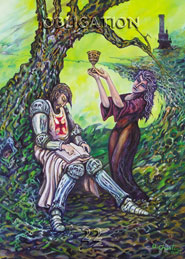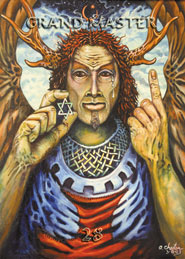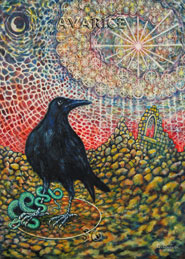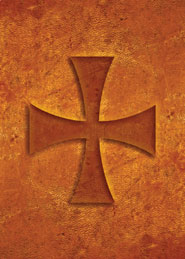Templar Tarot: The Journey Deck Review

Creators: Allen Chester, Stephan Dafoe
Published: 2009
The second edition of the Templar Tarot has greatly expanded upon the first, both in number of cards as well the revelations and lessons in the deck. There are 22 new cards - 21 majors plus an extra 'Ascension' card - making a total of 101 cards in the deck.
Retailers
See Price at Inspire by DesignTemplar Tarot: The Journey Review by Bonnie Cehovet
“This project is dedicated to the seekers of truth that desire to know themselves through the eternal wisdom of the ages.” Allen Chester, Artist
“Templar Tarot: The Journey” takes off where the “Templar Tarot” left off. Quite literally – the added (79th) card from the “Templar Tarot” becomes the first card in “Templar Tarot: The Journey”. The set includes the 79 cards from the original deck, an additional 21 cards (forming a second Major Arcana), and a 175 page companion book.
In his introduction, Etienne Thevou talks about the song played by the figure in the Magic Flute – the 79th card of the original deck, the first card of the new Major Arcana. Eight years after the publication of the original deck, it is now time for this new song to be played. In this new deck, the story of the Tarot unfolds alongside the story of the Templars. Where the story of the original “Templar Tarot” was a speculative story of the Templar knights, the new arcana tells the story from the point of historical reference.
In his artist’s statement, Chester notes that he paints primarily from a trance state, with music playing in the background. There were no conceptual drawing, no preconceived color schemes. In essence, past ideas and memories were allowed to be channeled into this work. The task of connecting his paintings to a written interpretation was entrusted to historian and author Stephen Dafoe. (Note: Mr. Dafoe is also founder and owner of “The Templar History Magazine”.)
In his introduction to “Templar Tarot: The Journey”, Dafoe speaks of the power of language and the power of symbols. He sees the Tarot as a form of meditative self-analysis, a psychology of symbolism. He also notes that the Tarot can be used as a mnemonic device, where the cards act as a book or a reference to a group’s teachings.
The new deck serves this purpose, as it expands on the revelations and lessons in the original Templar deck. It is meant to reveal the birth, life and death of the Templar Order, between the years of 1119 and 1314. Each card provides the student with a chapter in the Templar history, with symbolic contents drawn fro Pagan, Christian, Islamic, and Judaic thought and symbolism. Of course, not all has been revealed.
May those who seek, find.
May those who find, be transformed.
May those transformed, enlighten others.
(From the companion book.)
The companion book begins with the new Tarot cards, broken down into three divisions: Birth, Life, and Death. The titles are as follows:
Birth:
Card 22 Obligation
Card 23 Beatitude
Card 24 Semblance
Card 25 The True Cross
Card 26 Discipline
Card 27 Fecundity
Card 28 Grand Master
Life:
Card 29 Affinity
Card 30 Sapience
Card 31 Synthesis
Card 32 Jihad
Card 33 Quietus
Card 34 Darkness Visible
Card 35 Jinn
Death:
Card 36 Avarice
Card 37 Polarity
Card 38 Betrayal
Card 39 Interrogation
Card 40 Dissolution
Card 41 Caliginosity
Card 42 Pilgrimage
Card 000 Ascension
Each card is presented with an accompanying black and white illustration. Included in the text is the card’s Historic Context, Symbolic Context, Divinatory Meaning, and Reversed Meaning.
This is followed by a section on the original “Templar Tarot” cards, with the text by Daria Keller. The presentation for the Major Arcana is that of a black and white illustration of the card, accompanied by a paragraph on the card itself, followed by the Divinatory Meaning and the Reversed Meaning. The Court Cards and Pips (numbered cards) show a black and white illustration, an explanation of the card, and Divinatory and Reversed meanings.
The suits are Staves, Cups, Swords, and Pentacles. The Court Cards are entitled King, Queen, Knight, and Page. The Major Arcana titles, along with their associations, are as follows:
The Fool (The Pilgrim)
The Magician (The Troubadour)
The High Priestess (Mary Magdalene)
The Empress (Great Mother)
The Emperor (Dagobert II)
The Priest (The Pope)
The Lovers (Repanse de Schoye)
The Chariot (Saladin)
Strength (Bernard of Clairvaux)
The Hermit (John the Baptist)
The Wheel of Fortune (The Tarot)
Justice (King Solomon)
The Hanged Man (the Heretic)
Death (The Alchemist)
Temperance (The Grand Master)
The Devil (Rex Mundi)
The Tower (The Secret Tomb)
The Star (The Bloodline)
The Moon (The Cathars)
The Sun (The Gnostic Church)
Judgment (The Crucifixion)
The World (Ein Sof)
At the end of the book are instructions for doing a Three Card reading, along with the traditional ten card Celtic Cross spread.
For me, presentation of any work is of ultimate importance. I was impressed with how the deck and book were presented. The deck and book are in a black, hard cardboard box, held in a sleeve done in muted browns to give an antique appearance. The top of the sleeve shows the Templar Cross, while the bottom of the sleeve gives the appearance of a cover being drawn back to show the paper beneath it. On the corner that is revealed, we see a partial page from the website.
The cover of the accompanying book uses the same brown coloring, with the name of the deck, the names of the artist and author, and an illustration of the Templar Cross. The back cover shows just the brown coloring. The pages themselves are an antique cream color, with brown edging. At the bottom outer corner of each page a small illustration of the Templar Cross appears.
The cards themselves are 3 ˝” by 5”, on sturdy, non-glossy card stock. The backs are reversible, brown with the Templar Cross in the middle. The illustration on the faces goes to the edge of the card (there are no borders). The card name is centered across the top, with the card number centered at the bottom. Both appear in unobtrusive pale lettering/numbering, so that you have to look to find them. I found this to be a benefit, as it did not detract from the card. The art form is a very whimsical, fantasy style. (The Minor Arcana Pips show the number only, centered at the top of the card. The Court Cards show the title only, at the bottom of the card.)
From the new deck, the cards that I was most attracted to were Magic Flute (a flute playing figure with wings), The True Cross (a slender figure in blue carrying a green cross), Fecundity (a female figure in red, carrying a baby), Grandmaster (a Pagan-like male figure with antlers, three tear drops coming from the corner of his left eye, a Pentagram held in his right hand, and one finger of his left hand held up, pointing towards the sky), and Jihad (showing a Knight in armor sitting astride his horse, which is rearing up).
From the old deck, the cards that I was most attracted to were the Magician (a figure with multiple arms, in a light blue/white suit, walking on tiptoe), the High Priestess (shown seated, holding what appears to be a globe, with twelve stars acting as a Zodiacal halo around her head), the Emperor (shown seated in a meditative pose), the Priest (literally shown in modern day priest garb), Strength (which shows figure meditating in a room filled with jars and skulls), the Wheel of Fortune (which shows a winged figure doing a Tarot reading), the Hanged Man (who has all four limbs attached to lines, very much like a marionette), the Two of Pentacles (which shows a figure drawing pentacles in a book).
The Pages are all shown standing, the Knights are all seated on horses, and the Kings and Queens are all shown seated on their thrones.
I enjoyed reading about both the historical and the symbolic content in these cards. I feel that they would appeal to a collector, to someone that is interested in the Templars, to someone who wishes to work with meditation or journeying, or to someone interested in artistic decks. They would be best worked with by someone who already has at least some knowledge of the Tarot.
© Bonnie Cehovet
Templar Tarot: The Journey Review by Sapienza
‘Templar Tarot – the Journey’ is the second edition of the 2001 released Templar Tarot by artist and creator Allen Chester. This set is published by Inspire by Design and includes an additional twenty-two previously unreleased cards which are said to be an alternative major arcana. The set has 101 cards in total.
The deck and book are presented in an attractive slip case which has the appearance of leather with the Templar cross on the front. It measures 19 cm x 13.5 cm x 4.5 cm. Inside are the 175 page companion book and two stacks of cards.
The companion book contains a statement from the author but the bulk of the book concerning the new cards is written by Stephen Dafoe, an author and expert on the Knights Templar and Freemasonry. There is a much shorter section after this which is the original text from the Little White Booklet written by Daria Keller discussing the Original Templar Tarot.
In this review I will focus primarily on the new cards as there are many reviews of the Original Templar Tarot deck on this site already.
The addition of 22 extra cards takes this set outside my own personal definition of tarot. The new Major Arcana bear no obvious relationship to the traditional trumps. They may be related but, if so, any association is not immediately apparent and links to the traditional cards are not discussed explicitly in the book. Perhaps this is something one needs to ponder as they work with the deck. I would be more inclined to see these cards as an Oracle based on the Templar Knights that could be used in conjunction with the Templar Tarot. But maybe I’m just being a little too picky. The additional cards are divided into three sections called ‘Birth’, ‘Life’ and ‘Death’ and are titled as follows:
Birth:
Card 22 – Obligation
Card 23 – Beatitude
Card 24 – Semblance
Card 25 – The True Cross
Card 26 – Discipline
Card 27 – Fecundity
Card 28 – Grand Master
Life:
Card 29 – Affinity
Card 30 – Sapience
Card 31 – Synthesis
Card 32 – Jihad
Card 33 – Quietus
Card 34 – Darkness Visible
Card 35 – Jinn
Death:
Card 36 – Avarice
Card 37 – Polarity
Card 38 – Betrayal
Card 39 – Interrogation
Card 40 – Dissolution
Card 41 – Caliginosity
Card 42 – Pilgrimage
Card 000 – Ascension
The extra card from the Original Templar Tarot titled ‘The Magic Flute’ is included as Card 00.
In the Companion Book Stephen Dafoe explains that “the new Major Arcana cards have been aligned to expand on the revelations and lessons taught in the original Templar deck.” The new major arcana are designed to illustrate the story of the life, birth and death of the Templar order. The author provides a significant amount of information relating to each card. He gives the ‘Historical Context’, which provides historical information about the Knights Templar. Following this is the ‘Symbolic Context’ where he provides a commentary discussing the symbols found in Allen Chester’s artwork. Finally there are the Divinatory Meaning’ and ‘Reversed Meaning’.
The information about the Templar Knights is well written, easy to read and quite fascinating. I did find that it was sometimes a bit of a stretch to fit the card symbolism with the historical information provided. I also felt that some of the divinatory meanings were not unique in that they were covered by the meanings associated with other cards in the original tarot.
The second section of the book discussing the Original Templar Tarot provides for each major arcana card a commentary discussing the card symbolism and is then followed by the divinatory and reversed meanings. Each major arcana card is also associated with a character or figure related to the Templar Knights, such as Mary Magdalene for the High Priestess and King Solomon for Justice. The Minor arcana and Courts only have brief descriptions and meanings. The Courts also have characters associated with them such as Fulk of Anjou for the King of Swords and Verica of the Franks for the Queen of Cups. There is also a very brief section at the end of the book on working with the cards which includes two spreads.
The cards themselves measure 9 cm x 12.7 cm. They are printed on sturdy, thicker than usual card stock with a matte finish. I did at one time have a copy of the original deck and if memory serves me correctly the new deck is similar in feel to the original. My attempts to shuffle the full deck of 101 cards proved difficult with my relatively small hands. The deck measures almost 4.5 cm in thickness when stacked.
The backs of the cards are borderless with a leather look the same as the slip-case. The Templar Cross is in the centre in a slightly darker brown. The fronts of the cards are also borderless. The titles vary between the top and bottom of the card and are quite discreet so as not to detract from the image.
The cards are taken from individual oil paintings completed by Allen Chester. I think this medium works better for some cards than others. While many of the images are very clear and sharp, there are some that appear to my eyes quite blurred and in some cases rather difficult to look at. While the art is not to my own personal taste I know many others who find it stunning and so, as with all art, it becomes a matter of individual taste. The images are certainly rich with symbolism and emotion. The Major Arcana have titles based on the Waite-Smith deck with Strength at number 8 and Justice at number 11. The Minor Arcana suits are titled Swords, Staves, Cups and Pentacles. I find the use of Pentacles in this deck a little odd, but again, maybe I’m just being picky. The Courts are titled King, Queen, Knight and Page.
The additional 22 cards have the same style of artwork to the original deck however I find them quite a bit more appealing. Semblance shows a young girl, eyes closed, submerged in swirls while angels trumpet above as they surround a demon. Pilgrimage is a stunning card depicting a ship afloat on dark seas while the crescent of a full moon is illuminated in the background. Interrogation shows a figure hanging upside down that could possibly be related to the Hanged Man in the Original deck. There is a radiant quality to the artwork that I think differentiates it from the original cards.
For anyone with an interest in both the history and legends of the Knights Templar as well as tarot, this set is a must have. It provides the option to work with the full deck of 101 cards or alternatively to use the original deck and the new 22 cards separately. I feel that either option could be used successfully for readings as well as for personal growth work. The images lend themselves well to mediation and reflection. For those who are keen to learn more about the Knights Templar this set provides a visual journey which, when combined with tarot practice, is sure to prove insightful. While I never like to say that something is unsuitable for beginners, I would caution that if you are after a tarot that follows traditional meanings and symbolism then this might not be the right choice for you. For collectors this is definitely one to add to the collection.
Complete Details of Templar Tarot: The Journey
Creators: Allen Chester, Stephan DafoePublisher: Inspire by Design 2009
Deck Type: Tarot Deck
Cards: 101
Major Arcana: 45
Minor Arcana: 56
Card Size: 3.50 x 5.00 in. = 8.89cm x 12.70cm
Card Back: Reversible
Back Design: Templar cross on a leather-look background.
Companion Material: 175-page companion book.
Rating: 16/20 or
Similar Decks to Templar Tarot: The Journey
Category: Borderless Tarot Decks, Tarot Decks With Extra Major ArcanaCreator: Templar Tarot by Allen Chester
< Previous Deck · Back to Top · Next Deck >
Home > Tarot Reviews > Templar Tarot: The Journey Review







